Master Inbound B2B to Win High-Value Clients
October 20, 2025
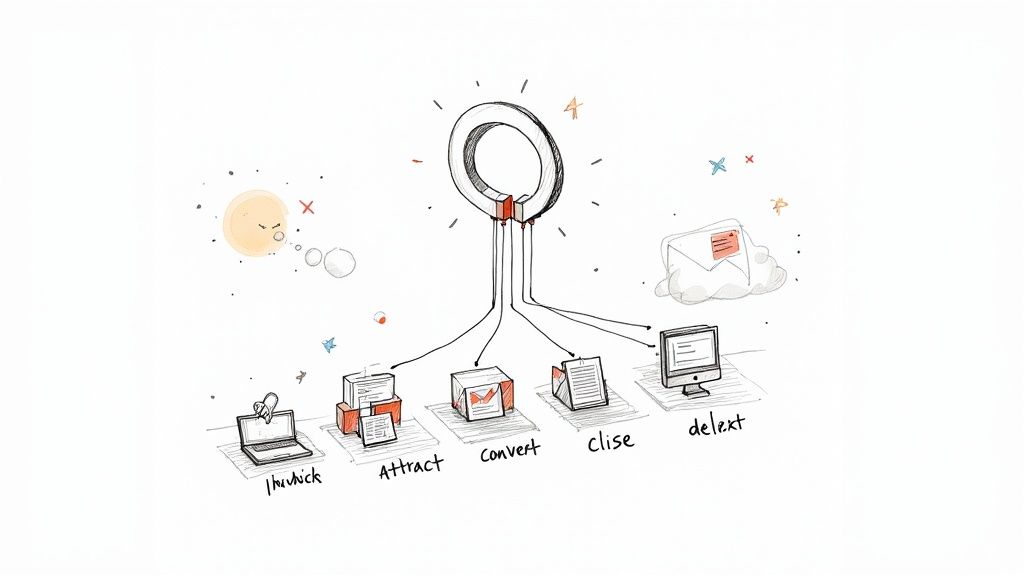
Inbound B2B marketing is a mindset shift, plain and simple. It’s a philosophy built on one core idea: earn attention, don’t just buy it. Forget the old playbook of interrupting potential clients with ads and cold calls. Instead, you create genuinely valuable content and experiences that pull them toward your business when they’re already looking for answers.
What Is Inbound B2B Marketing, Really?
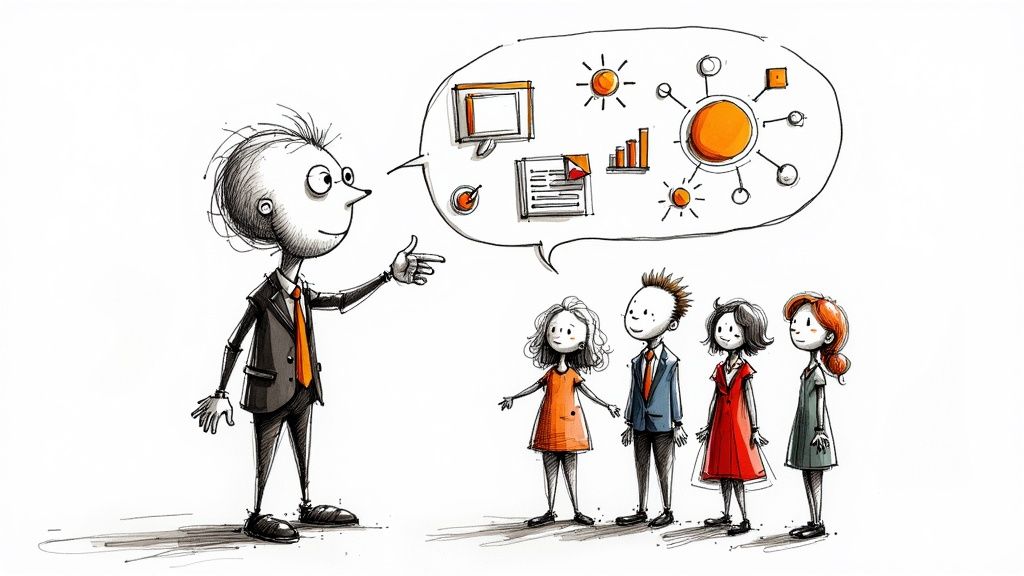
Imagine becoming the go-to expert in your industry. When B2B decision-makers have a problem, they think of your company first—not because you have the flashiest ads, but because you consistently offer clear, insightful guidance that helps them solve their biggest business challenges. That’s the heart of inbound B2B.
It's a magnetic approach, built on creating real value long before a single dollar ever changes hands. This flips your role from a persistent salesperson to a trusted advisor. Your ideal clients aren't just names on a spreadsheet; they're decision-makers searching for credible answers to complex problems.
And they are definitely searching. A staggering 77% of B2B buyers do their own extensive research online before they even think about speaking with a sales rep. Your online presence isn't just a brochure; it's your first—and often most critical—impression.
The Advisor vs. The Salesperson
Think about the fundamental difference here. An aggressive salesperson blasts through a prospect's day, hoping to catch them at the right moment. This traditional, or "outbound," method often feels intrusive because it’s all about the seller's timeline, not the buyer's needs.
An advisor, on the other hand, is a resource. They publish insightful articles, host educational webinars, and provide useful tools that speak directly to the pain points of their B2B audience. This isn't just marketing; it's authority-building. It establishes a foundation of trust.
Instead of pushing products, inbound marketing attracts potential customers by offering something valuable. When done well, it shortens sales cycles, builds trust, and brings in higher-quality leads who are already convinced you know what you're talking about.
This philosophy also transforms your marketing efforts from a short-term expense into a long-term asset. A great blog post or a comprehensive guide doesn't just generate a few leads today—it keeps attracting and educating qualified prospects for months, and sometimes even years, to come.
This table breaks down the core differences in approach:
Inbound vs Outbound B2B Marketing Approaches
Ultimately, the inbound approach respects the modern B2B buyer's journey. It meets them where they are, offering help instead of a hard sell, which is a far more effective way to build the kind of relationships that lead to sustainable growth.
Key Pillars of the Inbound B2B Method
This customer-first approach is built on a few core ideas that really set it apart from disruptive outbound tactics. It's a more sustainable way to grow by building meaningful business connections.
- Attraction Through Value: You create genuinely helpful content—like expert guides, original research, or detailed case studies—that answers the exact questions your ideal clients are typing into Google.
- Building Trust First: By providing solutions without asking for anything in return, you position your brand as a credible, reliable expert. You're not just another vendor; you're a partner in their success.
- Permission-Based Engagement: Prospects engage with you on their own terms, seeking out your content when they’re ready. This means that when they finally do reach out, the conversation is far more productive and welcome.
Why Inbound Is Your B2B Growth Engine
Let's be clear: inbound B2B marketing isn't just another set of tactics. It's a fundamental shift in how you build and scale your business. Instead of constantly paying to rent attention with temporary ad campaigns, you're building durable, valuable assets that pull in qualified leads around the clock.
Think of it as the difference between putting up a billboard on the highway and building the definitive library in your industry. The billboard gets seen, sure, but the library becomes a destination. People seek it out.
This approach plugs directly into the one metric that truly matters: sustainable growth. By delivering genuine value upfront—through insightful articles, deep-dive ebooks, and expert-led webinars—you lay a powerful foundation of trust. That trust is the catalyst that turns anonymous website visitors into high-quality leads who already see you as the expert.
From Content to Customers: The Inbound Flywheel
Here’s a powerful way to think about it: every piece of content you create is like an employee working for you 24/7. A well-researched guide doesn't clock out after a week. It keeps attracting, educating, and qualifying prospects for months, sometimes even years, delivering a far better return than ad spend that vanishes the moment you turn it off.
This process builds momentum over time. The more value you share, the more authority you build, and the easier it becomes to attract the right-fit business customers you actually want to work with.
This isn't just theory. It's a continuous growth cycle fueled by providing value first.
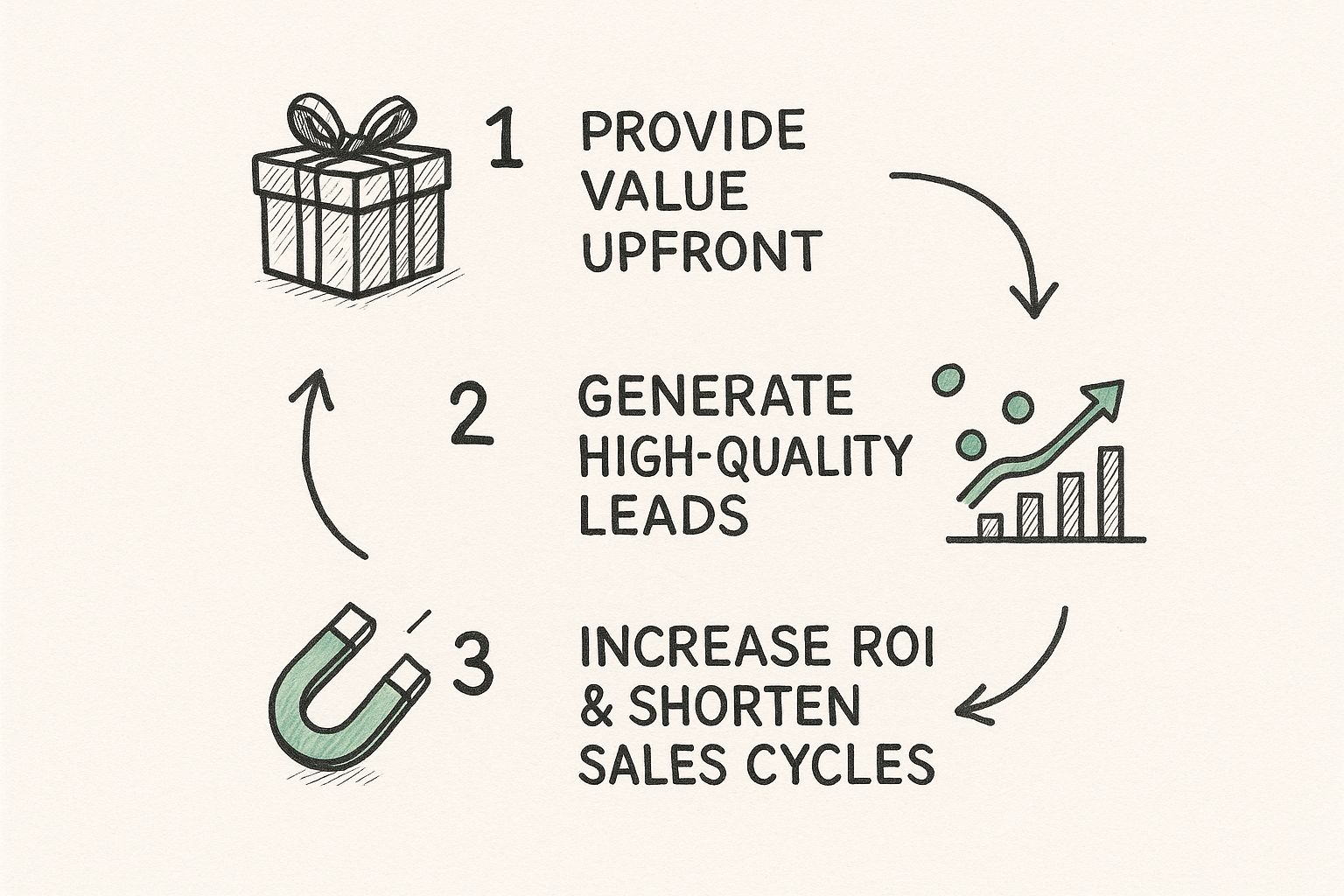
As you can see, the whole process starts with education. When you focus on teaching first, you naturally attract better-fit leads, which flows directly into a more efficient sales process and a healthier bottom line.
Shorten Sales Cycles and Increase Lifetime Value
The trust you build with an inbound approach has a massive impact on your sales team. When a lead comes to you already educated by your content, the conversation starts on a completely different level. You skip the basic "what is this?" and jump straight to solving their specific business problems.
This dramatically shortens the notoriously long B2B sales cycle.
Instead of spending weeks explaining the fundamentals, your sales team can focus on closing deals. Better yet, these relationships, founded on trust and value, lead directly to higher customer lifetime value (LTV). Customers who feel understood from the start are far more likely to stick around, expand their usage, and become your best advocates.
At its core, a successful inbound program creates a predictable pipeline of educated, motivated leads. It transforms marketing from a cost center into a reliable engine for business growth.
This is a critical piece of any solid go-to-market plan. To see how inbound fits into the bigger picture, you can explore this complete guide to building your B2B marketing strategy: https://www.bigmoves.marketing/blog/b2b-marketing-strategy.
Become the Industry Authority
In complex B2B buying decisions, expertise is currency. When a company is about to make a significant investment, they aren't looking for the loudest vendor—they're looking for the most credible one. Inbound marketing is how you solidify your company's position as that authority.
Of course, before any strategy can really take off, you have to be sure your product actually resonates with your B2B audience. This is where product-market fit comes in. You can learn more about how to find product-market fit from this fantastic resource.
By consistently publishing high-quality, insightful content, you become the go-to resource in your niche. This builds a powerful brand that attracts not just customers but also partners, top talent, and media attention. You stop chasing the conversation and start leading it.
Breaking Down the Four Stages of Inbound B2B
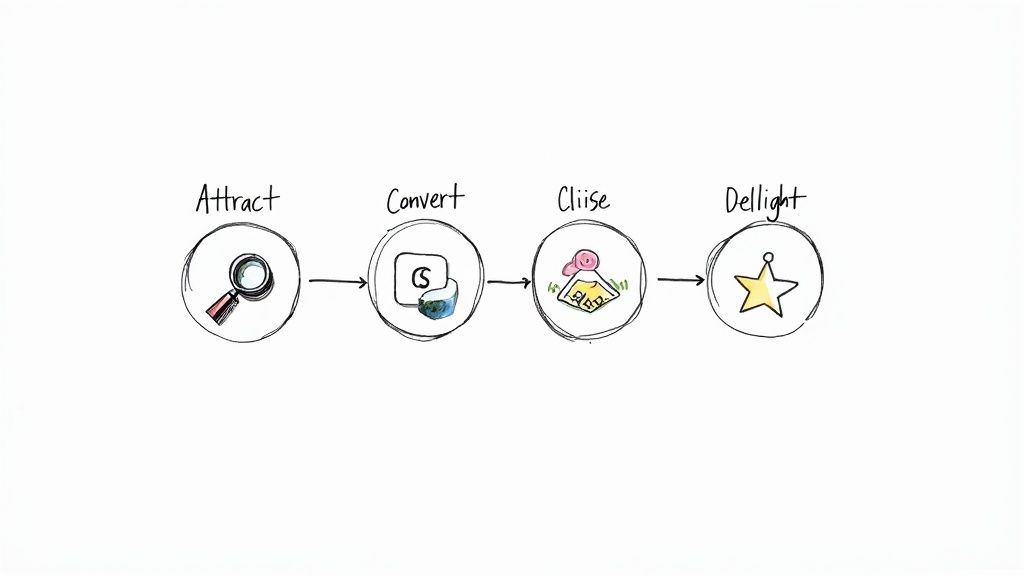
Inbound B2B isn't just a grab-bag of marketing tactics. It’s a structured journey that guides a potential customer from being a complete stranger to becoming your biggest fan. This journey plays out across four distinct stages: Attract, Convert, Close, and Delight.
Think of it like building any real business relationship. You don’t ask for a huge commitment on the first meeting. You start by being interesting and helpful, building trust over time until the other company sees your real value.
This four-stage framework gives you a clear roadmap, making sure every single marketing action you take has a specific, meaningful purpose.
The Attract Stage: Drawing in the Right Visitors
The first stage is all about becoming a magnet for your ideal customers. The goal isn't to get more traffic; it’s to get the right traffic. You want to pull in the decision-makers and influencers who are already out there searching for solutions to the exact business problems you solve.
How do you do it? By creating genuinely valuable content that answers their most urgent questions. This is where you stop selling and start teaching, establishing yourself as a trusted authority in your niche.
Key moves in the Attract stage look like this:
- SEO-Driven Blog Posts: Writing in-depth articles that are laser-focused on the keywords your target B2B audience is typing into Google.
- Expert Guides and Whitepapers: Creating comprehensive resources that offer deep dives into complex industry challenges.
- Social Media Engagement: Sharing your knowledge on platforms like LinkedIn where B2B professionals actually hang out and look for information.
By putting education ahead of promotion, you ensure the visitors landing on your site are qualified prospects who are genuinely interested in what you have to say.
The Convert Stage: Turning Visitors into Leads
Once you've got the right people on your site, the next step is to turn them into leads. This stage is all about earning their permission to start a direct conversation. You do this by offering them something even more valuable in exchange for their contact information.
This is a critical moment of trust. A visitor gives you their email because they believe the resource you're offering—an ebook, a webinar, a template—is worth the trade. Your job is to deliver on that promise with high-quality content that helps them take another step toward solving their problem.
The Convert stage is where anonymity ends and a real business relationship begins. By offering compelling, gated content, you build an active list of prospects who have raised their hand to hear more from you.
Effective conversion tactics include:
- Compelling Offers: Gated assets like ebooks, webinar registrations, or exclusive research reports that solve a very specific pain point.
- Clear Landing Pages: Dedicated pages with a single, clear purpose—to explain the value of your offer and make it incredibly easy to get.
- Frictionless Forms: Simple, short forms that only ask for the most essential information. Don't scare them away by asking for their life story.
Every conversion is an invitation to keep the conversation going, which sets you up perfectly for the next step.
The Close Stage: Nurturing Leads into Customers
Now that you have a list of qualified leads, the goal is to guide them toward becoming paying customers. The Close stage is where your marketing and sales teams join forces to help prospects make a final decision. In B2B, this is almost never a single event.
It’s all about building on the trust you’ve already earned through targeted, helpful communication. Companies that really nail lead nurturing generate 50% more sales-ready leads at a 33% lower cost. That’s the power of timely, relevant follow-up.
This stage is about showing how your solution specifically solves their unique business challenges. It requires a deep understanding of their needs, which you can map out to create a more effective B2B sales funnel.
Tools for closing deals include:
- Targeted Email Workflows: Automated email sequences that deliver the right content at the right time, triggered by a lead's behavior and interests.
- CRM Integration: Using a Customer Relationship Management (CRM) system to track every interaction, giving your sales team the context they need for meaningful conversations.
- Case Studies and Demos: Providing powerful social proof and personalized demonstrations that show your product in action, solving their exact problem.
The Delight Stage: Creating Vocal Advocates
Your job doesn't end when the contract is signed. The final—and most often forgotten—stage is Delight. This is all about turning those new customers into loyal clients and, ultimately, enthusiastic advocates for your brand.
This is where you lock in the relationship and create incredible long-term value. A delighted customer is your best marketing asset. They buy more, they stay with you longer, and they tell everyone in their network about their fantastic experience.
Delighting your customers involves:
- Outstanding Onboarding and Support: Ensuring a smooth transition and providing fast, helpful assistance whenever they need it.
- Continuous Value: Proactively sharing best practices, exclusive content, and new features that help them get even more successful with your product.
- Feedback and Community: Actively listening to their feedback (and acting on it!) and fostering a community where they can connect with and learn from their peers.
Master these four stages, and you’ll build a powerful, self-sustaining growth engine for your B2B business.
Choosing Your Key Inbound B2B Channels
Once you've got a handle on the inbound journey, your next big decision is picking the right channels to actually make it happen. Think of your strategy as the destination on a map; your channels are the roads that get you there. The key to inbound B2B isn't about being everywhere at once. It's about showing up where your ideal customers are already looking for answers.
Your focus should be on building a commanding presence on the platforms that deliver the biggest impact. For most B2B SaaS and tech companies, this boils down to mastering a core trio: Content Marketing, Search Engine Optimization (SEO), and strategic Email Marketing. These aren't just separate tactics; they're a powerful, interconnected system for attracting, engaging, and winning over high-value clients.
Content Marketing: The Bedrock of Your Strategy
Content is the absolute heart of your inbound engine. It's the tangible value you offer that pulls prospects in and lays the first bricks in a foundation of trust. But here’s the thing: not all content is created equal. The goal is to create assets that don't just answer a prospect's questions but firmly establish your company as the go-to expert in your space.
For B2B, two formats are absolute powerhouses:
Pillar Pages: Picture a pillar page as the ultimate, definitive guide on a broad, critical topic in your industry. It's a massive hub of information that then links out to more specific, detailed blog posts (we call these "cluster content"). This structure does wonders for your SEO, signaling to Google that you're a true authority on the subject and dramatically boosting your chances of ranking for those big, valuable keywords.
Case Studies: Nothing builds trust faster than showing you've done it before. A well-crafted case study is a story. It walks a potential customer through a real client's journey—from the initial challenge they faced to the incredible results they got with your help. It takes your solution from a theoretical idea to a proven, tangible outcome.
SEO: The Amplifier for Your Content
Creating amazing content is only half the battle. If your ideal customers can't find it, it might as well not exist. This is where Search Engine Optimization (SEO) becomes your most critical partner. SEO is the whole process—both technical and strategic—of making sure your content shows up when people search on Google.
Think of it like this: your content is the star performer, but SEO is the stage, the lighting, and the sound system. It ensures the audience can actually see and hear the performance. It’s all about making sure your valuable insights appear at the exact moment a potential B2B buyer is actively looking for them.
SEO isn’t just about stuffing keywords into a page; it’s about understanding and answering what the user is truly looking for. It ensures that when a decision-maker searches for a solution, your helpful, authoritative content is the first thing they find, establishing your credibility from the very first click.
Good SEO involves a mix of on-page tactics and technical groundwork. On-page SEO is about optimizing your content with the right keywords, clear headings, and good meta descriptions. Technical SEO makes sure your website is fast, mobile-friendly, and easy for search engines to crawl—all non-negotiable factors for ranking well. For a deeper look, check out our guide on the most effective B2B marketing channels that can work for you.
Email Marketing: The Engine for Nurturing Relationships
While content and SEO are masters of attraction, email marketing is where you build and deepen the relationship. Once a visitor gives you their email by downloading a guide or signing up for a webinar, email becomes your direct line for nurturing them toward a sale. It’s how you deliver personalized value straight to their inbox.
There's a reason email remains a powerhouse. A staggering 81% of B2B marketers use email newsletters as a core part of their content strategy, and 79% of B2B marketing agencies say email is their most successful channel for getting that content out there. Automation just adds to its power, with 82% of marketers using it to get higher engagement. These numbers point to one simple truth: email is exceptionally good at building the relationships that drive leads. Discover more insights about B2B marketing statistics on dbswebsite.com.
Strategic email for inbound B2B isn't about sending out generic blasts to everyone on your list. It’s about creating targeted lead-nurturing sequences that guide prospects along their decision-making path. For example, you can set up automated workflows that send relevant case studies, educational articles, or demo invites based on what a lead has shown interest in. This approach keeps your brand top-of-mind and builds the trust you need to close those complex B2B deals.
Building Your B2B Content Engine
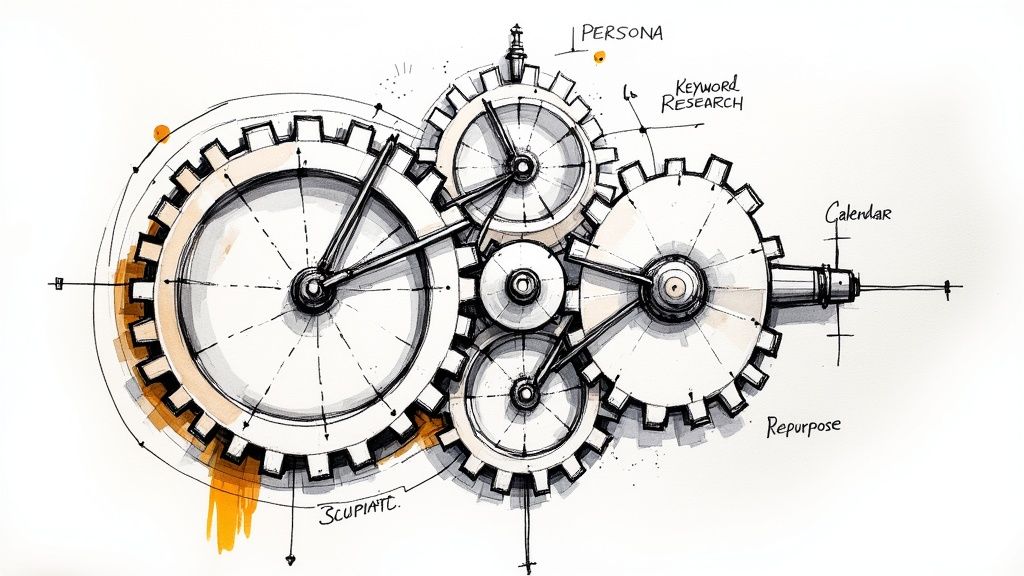
High-quality content is the fuel that powers every great inbound B2B program. It's the tangible value you offer that builds authority and, ultimately, pulls your ideal clients into your orbit. But tossing up a few blog posts here and there isn't a strategy—it's just noise.
You need to build a content engine. A sustainable, predictable system that performs day in and day out. And that engine doesn't run on guesswork; it runs on a deep, almost obsessive understanding of who you're trying to reach.
Start With Who, Not What
Before you write a single word, you have to know your B2B audience inside and out. This is where buyer personas become your most valuable asset. They’re not just demographic checklists; they're research-backed profiles that get to the real human drivers behind a business decision.
A strong B2B persona goes deep. It should answer questions like:
- What are their biggest professional headaches? Think about the daily frustrations and pressures they face in their role.
- What goals define their success? If you know what they're measured on, you can show them exactly how you help them win.
- Where do they find business information online? Pinpoint the industry blogs, LinkedIn groups, and publications they actually trust.
- What are their immediate objections to solutions like yours? Knowing their hesitations lets you get ahead of them.
A well-defined persona is your true north. It ensures every piece of content—from a blog post to a webinar—speaks directly to the right person, in the right way, about the right problems.
Uncover What Your Prospects Are Actually Searching For
With your personas locked in, the next step is to figure out what they’re typing into Google. Effective keyword research is the bridge between your audience's problems and your content. The goal isn't just to find popular terms; it's to identify intent-driven phrases that signal a B2B buyer is actively looking for answers.
Zero in on long-tail keywords—those longer, more specific search queries. "CRM software" is impossibly broad, but "CRM integration for financial services" shows clear intent from a highly qualified prospect. Building your content engine also means being efficient with your resources, so consider exploring the best AI tools for content creation to help streamline parts of this process.
Map It All Out With a Content Calendar
A content calendar is your roadmap for turning strategy into action. It’s a schedule that ties your content production to your bigger business goals, mapping specific topics to each stage of the buyer's journey.
Your calendar should organize content by the problems you solve for your audience:
- Awareness Stage: Content that helps prospects understand and name their problem (think blog posts, definitive guides).
- Consideration Stage: Content that helps them evaluate different ways to solve that problem (think case studies, webinars, solution comparisons).
- Decision Stage: Content that validates their choice to go with you (think product demos, implementation guides, ROI calculators).
This structured approach makes sure you have the right asset ready to guide a prospect from their first search to signing on the dotted line. To get more granular on this, you can learn how to define and scale your B2B content marketing strategy.
And finally, remember to work smarter, not harder. One great idea can fuel dozens of content pieces. A single webinar can be chopped up into blog posts, social media clips, an infographic, and an email series. This approach maximizes the impact of every effort, ensuring your valuable insights reach the widest possible audience.
Measuring Your Inbound Marketing Success
Let’s be honest. An inbound strategy is just a collection of nice ideas until you can prove it’s actually working. To show real impact, you have to look past the feel-good numbers like page views and social media likes. The true story of your success is written in the data that ties your marketing directly to business growth.
This isn't about getting lost in endless spreadsheets. It's about building a clear, convincing story that shows exactly how your efforts are creating a healthier, more predictable revenue engine. When you track the right KPIs, your inbound marketing stops being just a creative project and becomes a data-backed powerhouse.
KPIs That Truly Matter in B2B
A solid inbound program needs metrics that cover the entire journey, from that first blog post a prospect reads to the moment they sign a contract and beyond. These key performance indicators (KPIs) are your compass, telling you what’s working and where you need to make adjustments.
Here are the core metrics every B2B marketer should have on their dashboard:
- Marketing-Qualified Leads (MQLs): These aren't just random contacts. MQLs are prospects who have raised their hand and shown real interest by engaging with your most valuable content, like downloading a detailed ebook or signing up for a product webinar. Tracking MQLs is a direct measure of your lead generation engine's health.
- Lead-to-Customer Conversion Rate: This is the ultimate gut check for lead quality. This percentage tells you just how effective your inbound machine is at attracting prospects who eventually become paying customers. A high rate means your content and messaging are hitting the mark with the right audience.
The Financial Metrics of Inbound B2B Growth
Beyond lead generation, two financial metrics are absolutely critical for proving the long-term value of your strategy. These numbers speak the language of the C-suite and will get the attention of your leadership team.
Inbound B2B marketing isn't an expense; it's an investment in a sustainable growth asset. The real magic happens when you can demonstrate not just how many leads you're generating, but how much value each new customer brings to the business over time.
The two most critical financial KPIs are:
- Customer Acquisition Cost (CAC): This is the total cost of your sales and marketing efforts divided by the number of new customers you brought in over a specific period. A lower CAC means your inbound engine is running efficiently, attracting new business without burning through your budget.
- Lifetime Value (LTV): This metric forecasts the total revenue your business can expect from a single customer throughout your entire relationship. When your LTV is significantly higher than your CAC (a healthy ratio is often considered 3:1), you’ve proven you have a scalable, profitable business model.
By tracking these KPIs, you can build a powerful dashboard that tells a clear story of your success. To get started, you can explore this guide on how to measure marketing success for data-driven B2B growth. These metrics empower you to make smarter decisions, continuously improve your inbound strategy, and confidently show the incredible impact of your work on the company's bottom line.
Frequently Asked Questions About Inbound B2B
Shifting to an inbound model always brings up a few practical questions. This is where the rubber meets the road, and getting clear answers can mean the difference between building real momentum and hitting a wall. Here’s a rundown of the most common questions B2B leaders ask when they start putting this strategy into play.
How Long Until We See Real Results?
This is always the first question, and for good reason. Let’s be clear: inbound B2B is a long game, not a light switch you flip for instant leads.
While you'll probably spot early signs of life—like more website traffic or better social engagement—within the first 3-6 months, the results that really matter take longer. We're talking about a steady, predictable flow of marketing-qualified leads (MQLs), which typically takes 9-12 months of consistent effort to build up.
Think of it like planting a tree. You do the hard work of tilling the soil and planting the seed upfront, but the real growth happens over time, day by day. Consistency is everything here.
Do We Need a Big Budget to Start?
Not at all. While a bigger budget can definitely speed things up, you can absolutely start small and scale smart. The heart of inbound marketing is creating genuinely valuable content, and that’s fueled more by your team's expertise and time than by a massive ad spend.
To get started, focus your resources on just a few high-impact activities:
- Create one killer piece of content each month. Think a detailed guide, an original research report, or an in-depth case study.
- Optimize your website for a small, strategic set of high-intent keywords that your ideal customers are actually searching for.
- Build a simple email nurture sequence to stay in front of new leads and build trust over time.
You can get a surprising amount of traction by being laser-focused, even with a shoestring budget.
Can Inbound Work Alongside Our Outbound Efforts?
Absolutely—in fact, they work best together. The smartest B2B growth strategies don't treat them as an either/or choice; they blend them. Your inbound content warms up the market, making your sales team’s outbound calls far more effective and a lot less "cold."
Imagine a salesperson reaching out and being able to reference a webinar the prospect just attended or a blog post that solves one of their key problems. It provides immediate value and context, turning a cold interruption into a relevant conversation.
The two approaches feed each other to create a system that's more powerful than the sum of its parts. Inbound builds your brand's authority and pulls in interested prospects. Outbound lets your sales team proactively engage high-value accounts with a message that’s now more familiar, credible, and welcome.
How Is AI Changing Inbound B2B?
Artificial intelligence is quickly becoming a game-changer for personalizing and scaling inbound marketing. For instance, 32% of B2B buyers are already using or looking into AI for content creation, which helps marketing teams produce more relevant material, faster.
Beyond just creation, AI is powering much deeper personalization. In financial services, 27% of B2B buyers are using AI-driven tools to make sure every piece of content and outreach is perfectly matched to a buyer’s specific needs and context. While there are still things to sort out, like data security, AI is undeniably helping brands create more meaningful and effective interactions. You can see more data on these B2B marketing trends on gwi.com.
At Big Moves Marketing, I partner with B2B SaaS and AI startups to build the launch strategies and sales tools that drive real growth. If you need to translate your product’s features into a message that wins deals, let's connect: https://www.bigmoves.marketing
%20-%20Alternate.svg)
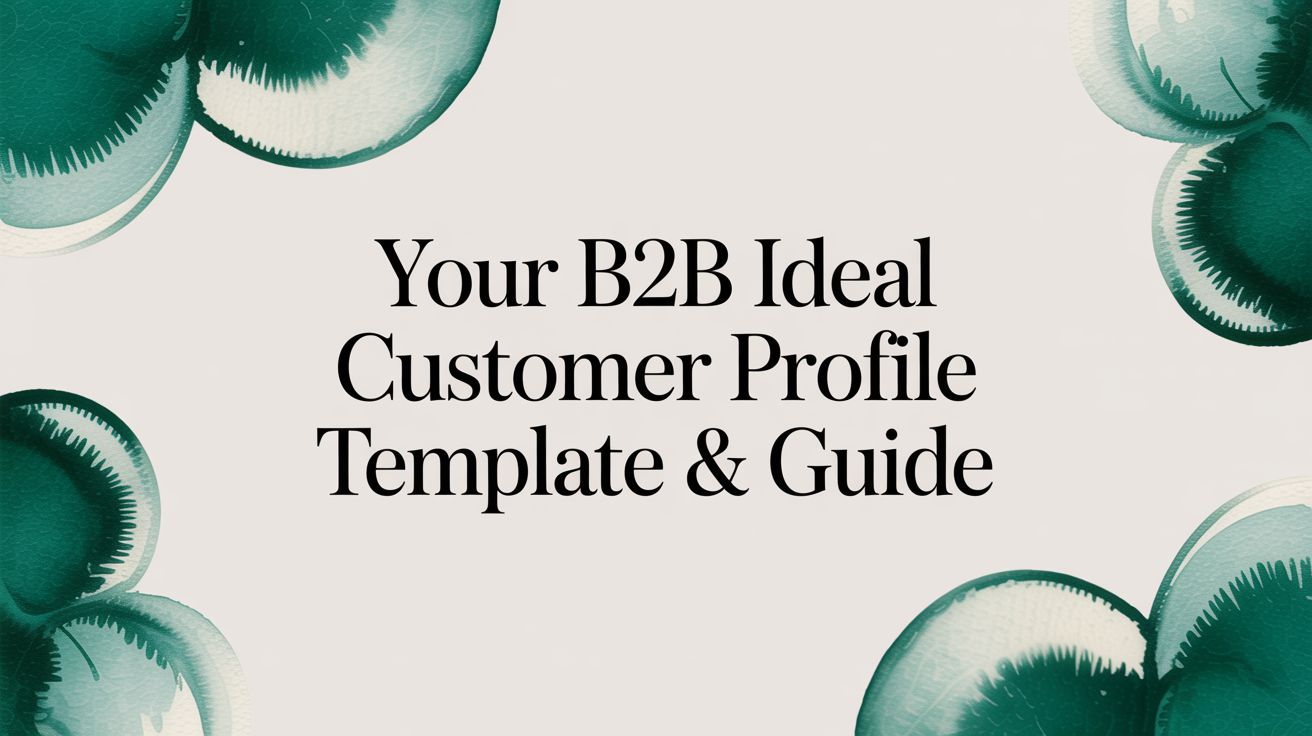

%20-%20white.svg)